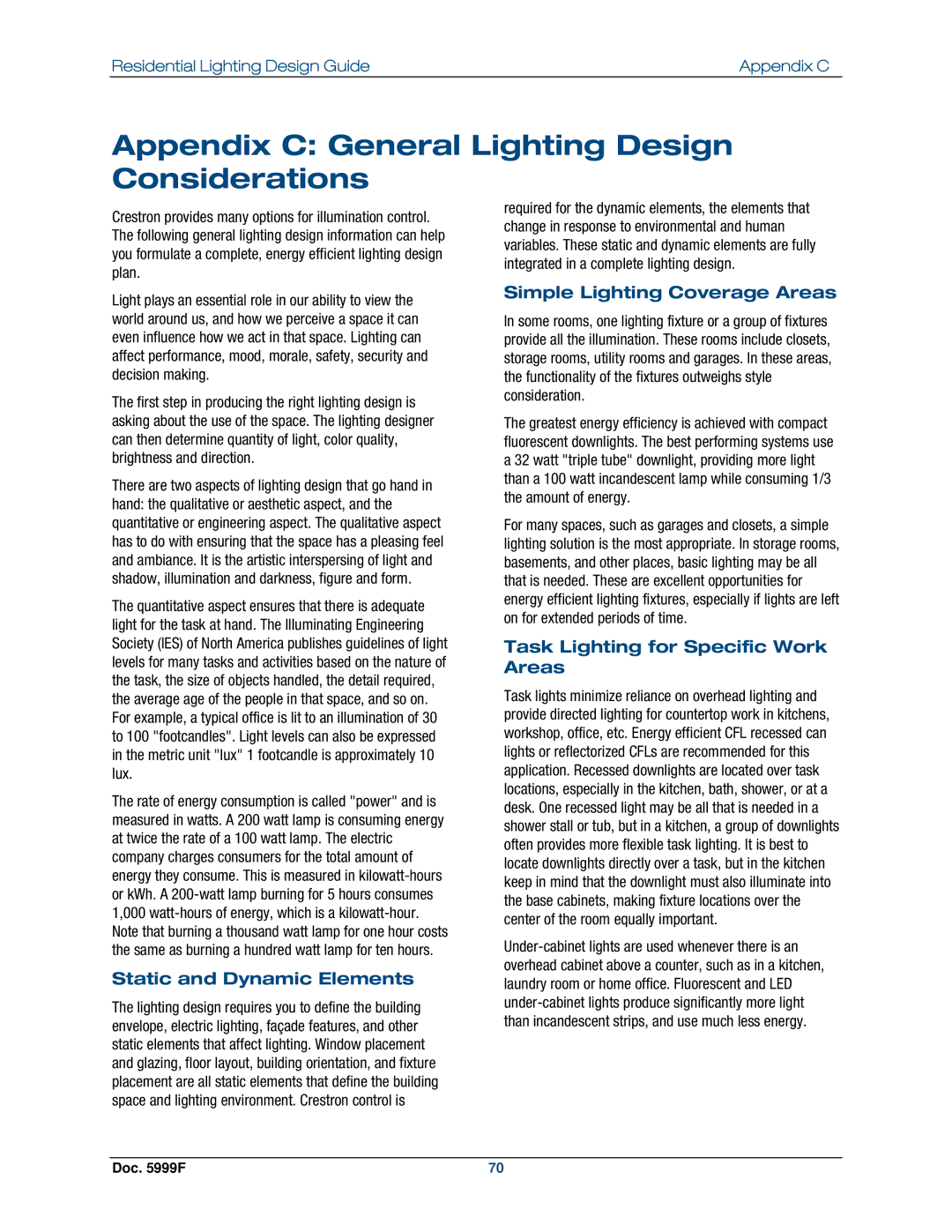Residential Lighting Design Guide | Appendix C |
Appendix C: General Lighting Design Considerations
Crestron provides many options for illumination control. The following general lighting design information can help you formulate a complete, energy efficient lighting design plan.
required for the dynamic elements, the elements that change in response to environmental and human variables. These static and dynamic elements are fully integrated in a complete lighting design.
Light plays an essential role in our ability to view the world around us, and how we perceive a space it can even influence how we act in that space. Lighting can affect performance, mood, morale, safety, security and decision making.
The first step in producing the right lighting design is asking about the use of the space. The lighting designer can then determine quantity of light, color quality, brightness and direction.
There are two aspects of lighting design that go hand in hand: the qualitative or aesthetic aspect, and the quantitative or engineering aspect. The qualitative aspect has to do with ensuring that the space has a pleasing feel and ambiance. It is the artistic interspersing of light and shadow, illumination and darkness, figure and form.
The quantitative aspect ensures that there is adequate light for the task at hand. The Illuminating Engineering Society (IES) of North America publishes guidelines of light levels for many tasks and activities based on the nature of the task, the size of objects handled, the detail required, the average age of the people in that space, and so on. For example, a typical office is lit to an illumination of 30 to 100 "footcandles". Light levels can also be expressed in the metric unit "lux" 1 footcandle is approximately 10 lux.
The rate of energy consumption is called "power" and is measured in watts. A 200 watt lamp is consuming energy at twice the rate of a 100 watt lamp. The electric company charges consumers for the total amount of energy they consume. This is measured in
Static and Dynamic Elements
The lighting design requires you to define the building envelope, electric lighting, façade features, and other static elements that affect lighting. Window placement and glazing, floor layout, building orientation, and fixture placement are all static elements that define the building space and lighting environment. Crestron control is
Simple Lighting Coverage Areas
In some rooms, one lighting fixture or a group of fixtures provide all the illumination. These rooms include closets, storage rooms, utility rooms and garages. In these areas, the functionality of the fixtures outweighs style consideration.
The greatest energy efficiency is achieved with compact fluorescent downlights. The best performing systems use a 32 watt "triple tube" downlight, providing more light than a 100 watt incandescent lamp while consuming 1/3 the amount of energy.
For many spaces, such as garages and closets, a simple lighting solution is the most appropriate. In storage rooms, basements, and other places, basic lighting may be all that is needed. These are excellent opportunities for energy efficient lighting fixtures, especially if lights are left on for extended periods of time.
Task Lighting for Specific Work Areas
Task lights minimize reliance on overhead lighting and provide directed lighting for countertop work in kitchens, workshop, office, etc. Energy efficient CFL recessed can lights or reflectorized CFLs are recommended for this application. Recessed downlights are located over task locations, especially in the kitchen, bath, shower, or at a desk. One recessed light may be all that is needed in a shower stall or tub, but in a kitchen, a group of downlights often provides more flexible task lighting. It is best to locate downlights directly over a task, but in the kitchen keep in mind that the downlight must also illuminate into the base cabinets, making fixture locations over the center of the room equally important.
Doc. 5999F | 70 |
